“Come to the Timberyard. We’re here weaving,” says Cristina Nicotra. It’s noon on Tuesday and an industrious gang of weavers and budding historians has gathered.
The Liberties Weavers run classes in a small, shared community room on the ground floor of the Timberyard, a modern social housing development on Cork Street in Dublin’s Liberties. The development is on the site of the former Strahan’s Timberyard, which once supplied wood for looms, shuttles, frames and spindles for the local weaving community.
Ten people are gathered around the large table, learning the craft, some textile history and keeping company. The voluntary community project honours a thousand years of textile and weaving heritage in Dublin 8 by organising weaving classes, community workshops, exhibitions and historical lectures for locals and visitors.
Weaving and textiles have long been embedded in the Liberties. From the Timberyard door Claire Byrne (no, not that one) points to what was once Atkinson & Co silk merchants, which pioneered Irish poplin and had the timber yard built to avoid having to transport looms. Byrne is chair of the Liberties Weavers and says Atkinsons made part of Queen Victoria’s trousseau. You might saucily speculate what specific underbeneaths they made but apparently that’s never been specified. (Let’s salaciously assume Victoria wore Irish knickers made in the Liberties.)
RM Block
There’s a large standing loom, finished tapestries and photos on the wall, and at the table the weavers are using a variety of small tapestry looms, some frames on the table, others perched in the lap, plus spindles and threads. They work and chat as tutor Mags Maxwell moves among them.
First, a demo: two sets of threads, the warp and the weft, interlace at right angles to create cloth. Each thread in the warp passes through holes or slots in a heddle, which is used to separate the warp threads for the passage of the weft. A rigid heddle makes it easier to thread the yarn between them. Eric O’Reilly demonstrates the upper and lower layers of thread on his tapestry frame, and how you weave between them. Mary Fitzgerald says there are double heddles on some looms, explaining how an upper and a lower layer of cloth emerges, useful for creating a wider fabric.
With the floor loom, you use pedals. Then there’s an inkle (Swedish for braid or band) loom: shaped like a plough, with dowels to thread around. This allows for more length, often for a narrower piece, say the strap of a bag, or a crios belt traditionally worn by fishermen from the Aran Islands. This crew is impressive: knowledgeable, interesting, outspoken. For the novice, it seems complex and technical, involving treddles, pedals and shafts; but it’s also calming.
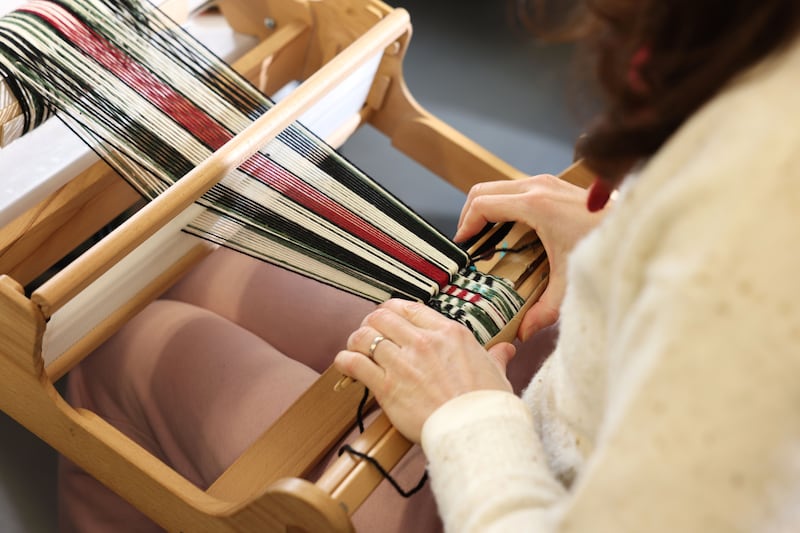
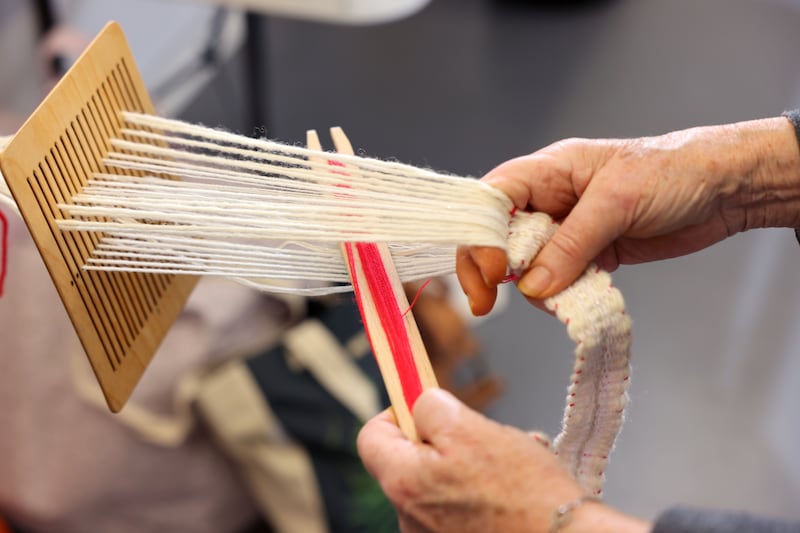
They are each working on a separate Brigid-related tapestry, which will be mounted on to large wood grids for an exhibition at Brigit: Dublin City Celebrating Women festival. Maxwell assigned each a Brigit-related concept and they designed their tapestry around it: protection, poetry, cloak, learning, spring, blacksmithing, Brídóg, cross. Flora Lacoponi’s work involves a reed Brigid’s Cross incorporated into the yarn tapestry. O’Reilly’s describes his elaborate design, and observes of his topic: “Spring is on the way, but it hasn’t appeared yet!” There’s much work still to do. “I’m going to be sleeping with this frame.”
The Liberties weaving project was born in 2018 when Marja Almqvist, textile artist and Education and Training Board adult education tutor, met Cathy Scuffil, Dublin City Council’s historian in residence. Passionate about weaving history, and realising they were in the centre of the almost forgotten silk industry, they started taster workshops, then a weaving course. Byrne, O’Reilly, Siobhán Lynam and Sally Hasson got involved and a seminar, exhibition and workshops in the new Hyatt hotel in January 2020 attracted more than 200 people. Even during Covid “we were weaving over Zoom”, says Byrne, who comes from a long line of weavers. She established The Liberties Weavers as an independent community group in February 2021.
They bought frames in charity shops to make small tapestry looms and borrowed blackstrap heddles, where you tie a belt around the waist, attach a little heddle to a hook on the wall, and “you weave to the wall”, using your body for tension.
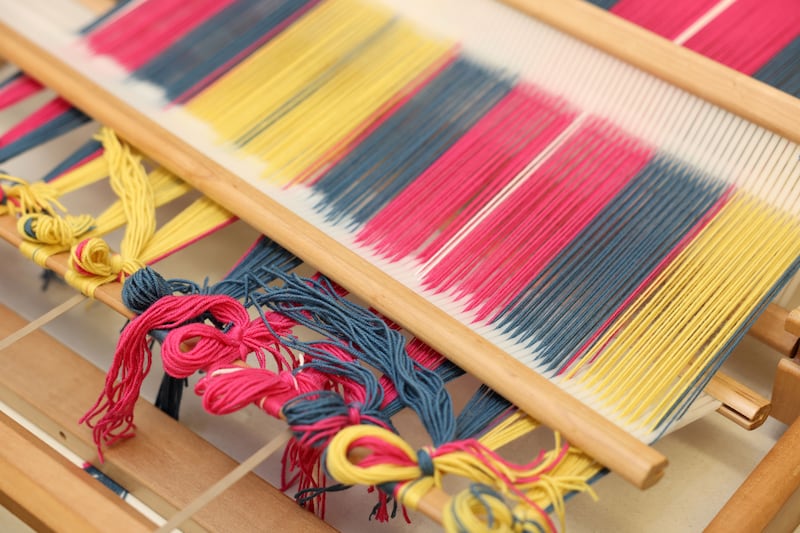
They raised some funds, got better looms and the classes grew. “The word went out,” says Lynam. “We were asked all over the place, and continuously, where can we join?”
There are now three weekly classes (beginners, intermediate, advanced) but space has always been an issue. This small, humble room, which is shared, is the only community space in the Liberties, they tell me. It only fits 10 weavers. There’s lots of interest, so there’s a long waiting list. With proper space they could offer so much more.
“If the space was open, people could come in and talk, and we could set out stuff,” says Sandra Chase. “We’re a giving group. We want to give the information out. No one takes it to the grave, thanks very much.”
This initiative counters the narrative that the Liberties’ sole focus was as a centre of brewing. The place is soaked in its textile history, tumbling out in the chatter around the weaving table. The former Timberyard and Atkinson’s silk merchants aren’t the half of it. The clues are everywhere.
Francis Street was the centre of commerce for the textile trade. Multiple street names, buildings and businesses bear witness to textile heritage over generations. Crossticks Alley (cross sticks are used in weaving). Weavers Close. Weavers Hall (guildhall demolished in 1965). Weaver Square. Weaver Park. Handkerchief Alley. Flag Alley. Engine Alley, off Meath Street at the entrance to Liberty Market, was originally Indian Alley, on foot of its former Indian cotton and raw silk market, and was Dublin-ised to “Injun”, eventually morphing to engine. The Tenters were the tenterfields, where locally-woven wool and linen was stretched on tentering hooks (“on tenterhooks”) over large wooden tentering frames.
Cow Parlour is from coup parlais or coupeurs d’ourlets, referring to hem-cutters. Marrowbone Lane is a corruption of Marie Le Bon, from the Huguenot refugees who introduced Jacquard looms, as well as the distinctive gable-fronted 17th and 18th century Dutch Billy houses (looms were at the single window at the top; 10 Mill Street is extant).
The Liberties’ weaving connection dates to before the Viking period, when there was a dense concentration of weavers in the area. Weaving expanded at various times over following centuries, especially when tens of thousands of French Huguenots, primarily weavers and textile merchants, established themselves in the 1600s onwards. Their damask silk weaving led to the development of Irish poplin, combining silk and wool, to avoid tax. It became a luxury export.
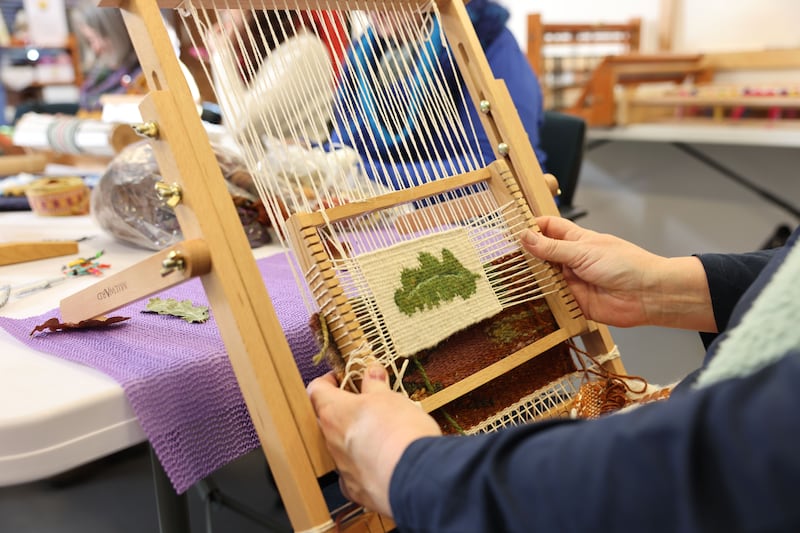
The 18th century Liberties was a textile hub but tariffs imposed by England in the 19th century were a fatal blow to the industry. Even as late as the 1911 census, however, 400 people identified themselves as weavers. Botany Weaving, the world’s largest airline upholstery manufacturer (also on the Luas) has been in the same building on Cork Street since 1932, the last remaining weaving business in the Liberties.
The Liberties Weavers are conscious of this heritage, as well as committed to learning and teaching weaving techniques, and sharing the therapeutic benefits of creating cloth from thread.
There’s great banter in the Timberyard as they talk about what they’ve learned, both history and skills. They spin a good yarn. (Boom.)
Most of them are from or living in the area: “blow-in, blow-out or blow-back”, says Chase.
Cristina Nicotra (originally from Milan) observes, “it’s a very inclusive group, and the Liberties has a long history of welcoming foreigners through the centuries”. Flora Lacoponi from Tuscany has lived in the Liberties since 2008. She shows me photos of the first tapestries she made, of the Dutch Billy houses, and her own cottage; “like children” drawing their own home, she laughs. Mary Fitzgerald shows me a yoga belt or crios she wove on an inkle loom, with a pattern based on a Viking design from the Oseberg ship.
Mags Maxwell took over as tutor when Marja Almqvist retired. She’s wearing a wide linen hairband she wove, and on the wall is a tapestry she wove between a “frame” of branches. Weaving is in her DNA: studying the 1938 Schools Folklore Collection she discovered her grandfather, whom she didn’t know, was a basket weaver (“my father could weave any kind of a basket for any kind of occasion”, her aunt wrote). She also learned from the collection that her great-grandmother was a weaver and a spinner.
Sally Hasson from Scotland is interested in all kinds of arts and crafts, particularly weaving because of its Liberties associations. She has a drop spindle in her lap, spinning yarn from a lump of black wool for her Brigid tapestry, of a sheep. She says Mary Fitzgerald got the wool from a sheep in Kerry.
They talk about developing awareness of the origins of yarns. “Do we have some of Hilary?” someone asks. A farmer gave them Hilary’s fleece. Almqvist met him in a shop, wondering what he could do with fleeces, which nobody wants. “He arrived up here with a big bag of sheep fleeces.”
They find the bag of Hilary, and we can smell and feel the oil. “It’s beautiful,” says O’Reilly.
Fitzgerald also brought some alpaca back from holidays. We compare their distinct textures; the alpaca is very soft. “I never thought I would be here with a big sheep’s fleece, taking poo out of it!” says Byrne.
There’s a lot of work involved in making wool from the sheared sheep usable. They also recycle wool and buy new yarns. Linen is a favourite for many. At one stage they experimented with growing flax for linen in the local community garden. “It took a couple of years, needs loads of water and is very hard on the ground,” says O’Reilly.
Mary Bale says they’re “putting our toes in the water” with processing. “You can’t help it. When you work with fibre, you start someplace and then all the other parts of it start to sound interesting. And oh, I’d like to take that fleece and spin it, or weave it, or dye it.”
Nicotra talks about sustainability: “We are disconnected from what we wear and how it’s made. In this way you start to be curious and have much more connection with where our fibres are coming from and the beauty and the work behind that.”
Siobhán Lynam has lived and worked – in education and development – in the area for years. “I’m interested in its history, geography, stories, the literature, the spirit.” She describes her interest in weaving as wanting “to go out to play”, rather than the technical design. “I like telling stories.”
She points out one of her tapestry stories, about housing, on the wall. The detailed, forthright piece features the Augustinian church on Thomas Street, Patrick’s Tower on James’s Street and children playing on skateboards on Weaver Square. “Hilary is up there in the clouds.” There’s also the area’s surfeit of towering hotels, and “student accommodation, which sometimes is only a third full, because nobody can afford it”, and demonstrators’ banners “public housing on public land”.
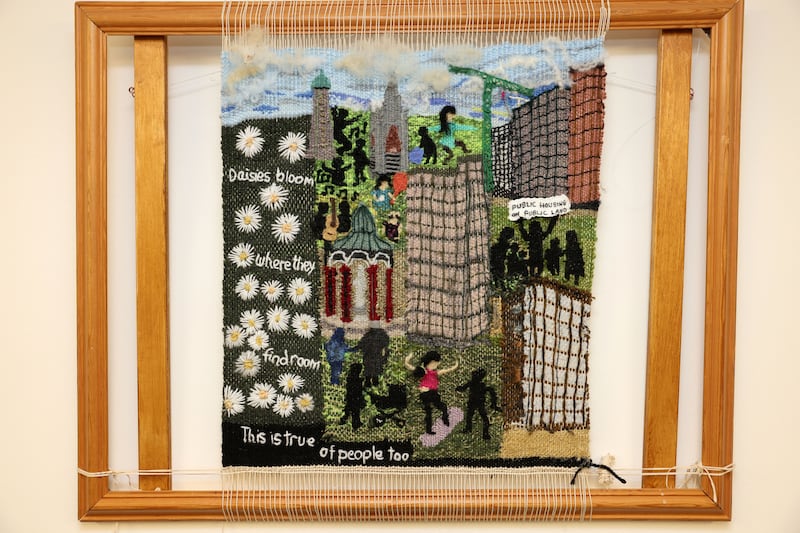
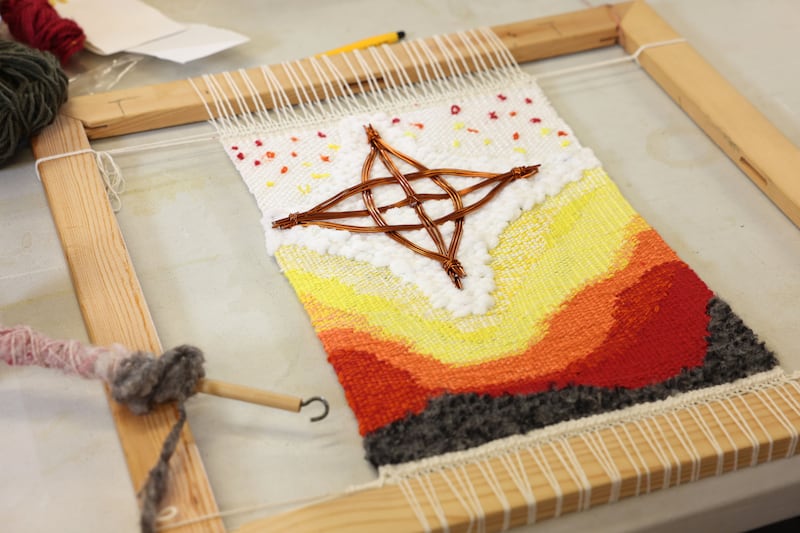
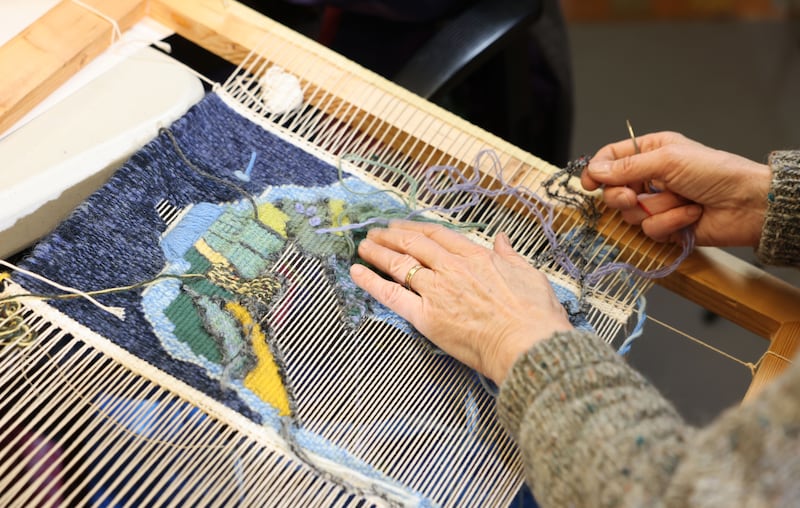
“The most important thing,” says Lynam, “is the statement” woven into it. “Daisies bloom where they find room. This is true of people too.” It’s a comment on challenges facing the area, where development threatens the community. “There’s no public spaces any more. The parish centre has gone, the public baths have gone, the Rupert Guinness Hall. The Liberties Music and Drama Group, where Imelda May started, has no place to meet or perform. They have to get a bus to someplace outside.”
As The Liberties Weavers have thrived, its tentacles have spread, developing The Liberties Weavers Walking Tour during Heritage Week last year, led by Anne Marie Hayes. A Weaving Map of the Liberties on its site, with illustrations by NCAD student Sophia Ricotta who proposed the mapping project, shows how embedded textiles are. Audrey Lewis and Fiona Murphy, film-making students of Champlain College Dublin, made a documentary, also on the website. A clutch of awards for heritage and community engagement, from Pride of Place to Aontas adult learning awards, are piled high on a shelf.
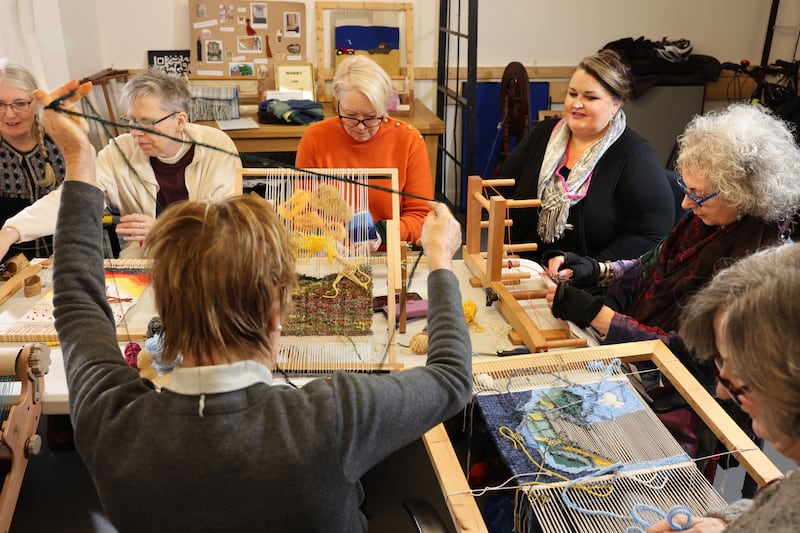
Much has been made of distilleries and breweries in the Liberties, but its fascinating textile culture remains in the shadows. Here’s a perfect marriage of craft, heritage and community in a city neighbourhood, but with no base. The potential – for learning, heritage, tourism, community development – is screamingly obvious, and The Liberties Weavers are well aware of it: “We’ll be taking over the world next!” Industriousness and commitment glows from its members, who want to creatively develop the skills and culture for future generations locally and nationally, and for tourism.
Dublin City Council has been very supportive, and many people locally love what they do and want to see them succeed. It’s an impressive operation built and run by volunteers with some small grants, operating out of this small shared community room, clearing their tools and looms and equipment away after every session. The dream is for a studio, shop and cafe, and a living history museum. “Think of fashion throughout the ages, and here in Dublin,” says Lynam, suggesting “Iveagh Markets, given its history, could be a perfect place for young designers, sustainable fashion, a textile museum.”
Byrne talks about the urban landscape. “The sounds and the sights are all part of it, the skyline of this part of Dublin inner city. That all plays into the colours we choose. It’s not something that takes away from our weaving, it adds to it.”
In the meantime, Lynam despairs about “accommodation buildings where nobody is living. Retail buildings where the ground floors are empty”, and still nothing at the cultural space in the aparthotel at the former Tivoli Theatre.
“If I’d been reared seeing somebody spinning wool, even with a drop spindle, it would’ve made such a difference,” says Sandra Chase. “I can knit because all my sisters can knit, because it was in the house. But there’s nothing like being out in the community and meeting people and teaching each other a stitch or how to pick up.” Bale agrees: “You learn so much more by being round a table than you ever would at home on YouTube. And it’s more enjoyable.”
Brigid with the Liberties Weavers exhibition is at the Pallas Projects/Studios in The Coombe, Dublin, on February 1st and 2nd as part of Brigit: Dublin City Celebrating Women festival, February 1st-5th dublin.ie



















